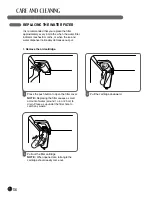
42
BEFORE CALLING FOR SERVICE
(CONT.)
Problem
Possible Causes
Solutions
Food stored in
refrigerator
drawers freezes.
Temperatures in
the refrigerator or
freezer are too
warm.
Temperature in
the refrigerator
is too warm,
but the freezer
temperature is
satisfactory.
Louder sound
levels when
compressor
comes on.
Vibrating or
rattling noise.
Moisture collects
on the inside walls
of the refrigerator.
Moisture forms on
the outside of the
refrigerator or
between the doors.
• Refrigerator control is set too
cold.
• Freezer or refrigerator control
is set too warm.
• Doors are opened too
frequently or for too long.
• Door is slightly open.
• Large amounts of warm or
hot food may have been
stored recently.
• Refrigerator has recently
been disconnected for a
period of time.
• Refrigerator control is set too
warm.
• Refrigerator operates at
higher pressures during the
start of the ON cycle.
• Floor is uneven or weak. The
refrigerator rocks on the floor
when it is moved slightly.
• Items placed on the top of the
refrigerator are vibrating.
• Dishes are vibrating on the
shelves in the refrigerator.
• The refrigerator is touching
the wall or cabinets.
• The weather is hot and humid
which increases the rate of
frost buildup and internal
sweating.
• Door is slightly open.
• Door is opened too often or
for too long.
• Weather is humid.
• Door is slightly open.
• Adjust the refrigerator to a warmer setting.
• Adjust the freezer or refrigerator control to a
colder setting until the freezer or refrigerator
temperature is satisfactory.
• Warm air enters the refrigerator/freezer whenever
the door is opened. Open the door less often.
• Close the door completely.
• Wait until the refrigerator or freezer has had a
chance to cool food to the set temperature.
• It takes a few hours for the refrigerator to reach
the set temperatures.
• Adjust the refrigerator control to a colder setting.
• This is normal.
• Be sure floor is level and solid and can adequately
support the refrigerator.
• Remove items.
• It is normal for dishes to vibrate slightly. Move
dishes slightly. Make sure refrigerator is level and
firmly set on floor.
• Move the refrigerator so that it does not touch the
wall.
• This is normal.
• Close the door.
• Open the door less often.
• This is normal in humid weather. When humidity is
lower, the moisture should disappear.
• Close the door completely.
Summary of Contents for LFX25978 Series
Page 50: ...50 ...
Page 51: ...51 ...
Page 52: ......
Page 101: ...101 ...
Page 102: ...102 ...
Page 103: ...103 ...
Page 104: ......
Page 153: ...153 ...
Page 154: ...154 ...
Page 155: ...155 ...
















































